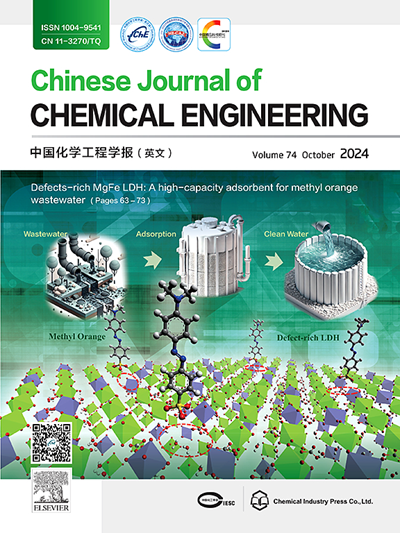均匀分散的铌基合金/碳纳米纤维作为高效储钠阳极材料的制备
IF 3.7
3区 工程技术
Q2 ENGINEERING, CHEMICAL
引用次数: 0
摘要
针对银基负极材料在合金化/脱合金过程中体积膨胀严重的问题,提出了静电纺丝与氢还原相结合的策略,制备了一系列银基合金/碳纳米纤维复合材料(SbM/CNFs, M = Co, Zn, Ni)。创造性地引入非活性元素,形成具有增强稳定性的Sb基合金。结果表明:纳米SbCo含量高达69.12%(质量),均匀分布在碳纤维中;作为sib阳极材料,SbCo/CNFs阳极表现出优异的储钠能力,在0.1 A g−1条件下,初始放电容量为580.0 mA h·g−1,循环100次后可保持483.5 mA h·g−1。即使电流密度增加到1.0 A g−1,循环150次后比容量仍保持在344.5 mA h·g−1。由于导电碳纤维和分散均匀的SbCo纳米颗粒的协同作用,钠存储容量的提高不仅提供了优异的电子导电性,而且增强了结构稳定性,减少了体积变化。本文章由计算机程序翻译,如有差异,请以英文原文为准。

Fabrication of Sb-based alloys/carbon nanofibers with uniform dispersion as anode material for high efficiency sodium storage
To solve the serious volume expansion problem of Sb-based anode materials in the alloying/dealloying process, a strategy combining electrospinning and hydrogen reduction is proposed to prepare a series of Sb-based alloys/carbon nanofiber composites (SbM/CNFs, M = Co, Zn, Ni). Inactive elements are innovatively introduced to form Sb based alloys with enhanced stability. The results show that the content of SbCo nanoparticles is high to 69.12% (mass), which are uniformly dispersed in carbon fibers. When evaluated as anode material for SIBs, SbCo/CNFs anode exhibits excellent sodium storage capacity, the initial discharge capacity is 580.0 mA h·g−1 at 0.1 A g−1, which can hold 483.5 mA h·g−1 after 100 cycles. Even the current density increases to 1.0 A g−1, the specific capacity still maintains at 344.5 mA h·g−1 after 150 cycles. The improved sodium storage capacity is attributed to the synergistic effect of conductive carbon fibers and SbCo nanoparticles with uniform dispersion, which not only provide excellent electronic conductivity, but also enhance structural stability to reduce volume change.
求助全文
通过发布文献求助,成功后即可免费获取论文全文。
去求助
来源期刊

Chinese Journal of Chemical Engineering
工程技术-工程:化工
CiteScore
6.60
自引率
5.30%
发文量
4309
审稿时长
31 days
期刊介绍:
The Chinese Journal of Chemical Engineering (Monthly, started in 1982) is the official journal of the Chemical Industry and Engineering Society of China and published by the Chemical Industry Press Co. Ltd. The aim of the journal is to develop the international exchange of scientific and technical information in the field of chemical engineering. It publishes original research papers that cover the major advancements and achievements in chemical engineering in China as well as some articles from overseas contributors.
The topics of journal include chemical engineering, chemical technology, biochemical engineering, energy and environmental engineering and other relevant fields. Papers are published on the basis of their relevance to theoretical research, practical application or potential uses in the industry as Research Papers, Communications, Reviews and Perspectives. Prominent domestic and overseas chemical experts and scholars have been invited to form an International Advisory Board and the Editorial Committee. It enjoys recognition among Chinese academia and industry as a reliable source of information of what is going on in chemical engineering research, both domestic and abroad.
 求助内容:
求助内容: 应助结果提醒方式:
应助结果提醒方式:


